子宫肌瘤在医学上称为平滑肌肉瘤或纤维瘤, 是生长于子宫肌层内的良性肿瘤。子宫肌瘤是由肌肉和纤维组织组成的,因此子宫肌瘤的质地十分结实。
子宫肌瘤是妇女中最常见的良性肿瘤。它常发生在年龄介与中至后期(段)的生育年龄 (一般是30岁以上) 但也可能发生在部分年轻的女子身上(20岁)。这类肿瘤能以个別形式生长(种类可多达上百), 存在的体积可从小至一棵豌豆,大至一个冬瓜般出現。
类型l
子宫肌瘤是根据它们生长在子宫内部的位置來分类。主要可分为三种类型的肌瘤:
1) 粘膜下子宫肌瘤
生长在子宫内膜下淺层的肌瘤。
2) 肌壁间子宫肌瘤
生长在子宫肌壁内的肌瘤。
3) 浆膜下子宫肌瘤s
生长在子宫外层的肌瘤。
有些肌瘤是由一个细柄,喻为蒂附着于子宫. 这些肌瘤一般被称为带蒂肌瘤。 对于生长在子宫颈的内肌瘤是比较罕见,它被喻为子宫颈肌瘤。
子宫颈内生长的肌瘤(相对罕见)被称为宫颈肌瘤。
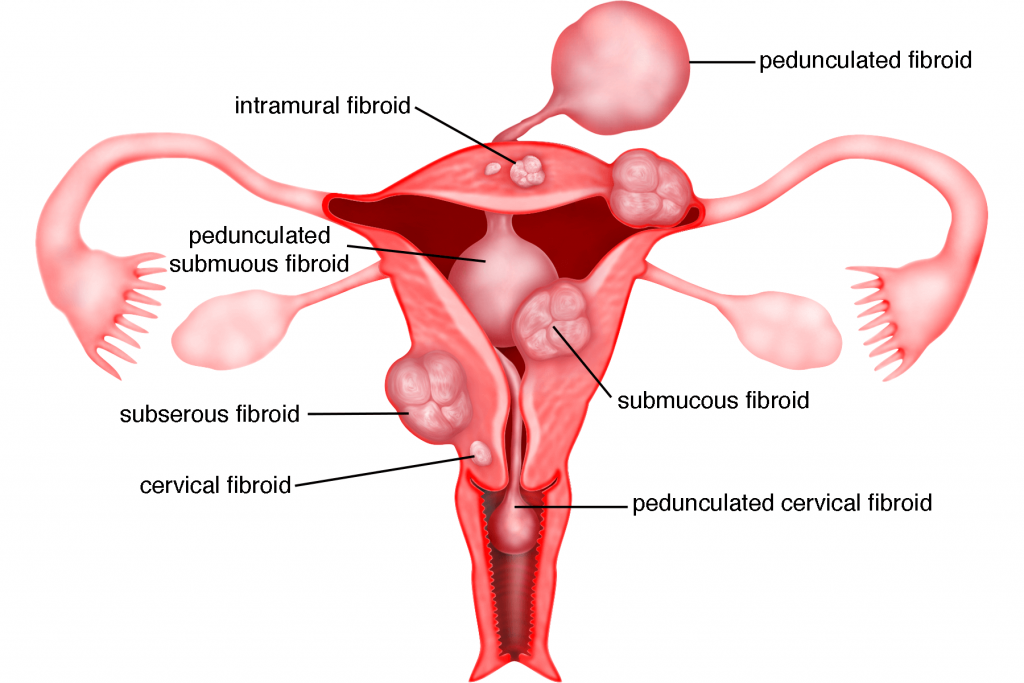
成因
子宫肌瘤的真正成因不明但却与家族遗传病史,种族和雌激素的水平等因素息息相关。
1) 家族遗传病史
许多被证实患有子宫肌瘤的妇女都拥有家族遗传病史。這足以令人相信,肌瘤是因出身时单个肌细胞突变演生而成的。
2) 种族
研究人员认为,非洲裔美国女性(african-american)比其他女性患子宫肌瘤的机率高达2至3倍。虽然高机率的真正成因不明,但据推测,基於遗传性倾向可能引发此疾病,致使此疾病常发生在年轻的非洲裔妇女身上; 並且这些妇女也趋向於同时拥有多个和大体积的子宫肌瘤。
3) 雌激素水平
许多患有子宫肌瘤的妇女被发现拥有高水平的雌激素. 虽然目前还不清楚雌激素对此疾病的誘因,但子宫肌瘤就像子宫内膜异位症一样已被证实依赖着激素来生长。因此, 一些妇女在更年期的过渡期間间遭遇子宫肌瘤恶化的症状。原因是她们的雌激素水平在这阶段异常的高; 但在更年期后由于雌激素水平显著下降,该症状便能安稳下來。在缺乏雌激素的情况下,子宫肌瘤将会萎缩,有时甚至会消失,无需任何治疗。
Case 2.1 : 5 of 6 sisters with fibroids
Miss LSP was a 46 year old single lady who came to see me in June 2003 with a problem of abdominal distension. Her menses was regular but heavy with occasional clots. Examination revealed a pelvic mass that reached up to 4 cm above the umbilicus (g), (24 gestational weeks size – like a 6 month pregnancy). Abdominal ultrasound showed an enlarged uterus with multiple huge fibroids. She underwent a laparotomy and myomectomy. 24 fibroids of varying sizes the largest 13 cm in
longest diameter were removed (see Figure: 2.9). Postoperatively, she was well. She is on regular follow up. Her fibroids have recurred since 2005. However, the largest has remained the same size (4.5 x 4.6cm) for many years. She attained menopause in 2008 at the age of 51.
Miss LSL saw me in 2003 after her sister was diagnosed with fibroids. She was 37 years old and single. Her periods were regular and not heavy. Examination revealed a large pelvic mass reaching 2 cm above the umbilicus (22 gestational weeks size). Ultrasound showed multiple uterine fibroids. She also underwent a myomectomy. 20 fibroids were removed and the total weight of the fibroids was 3.9kg (see Figure 24.8). The largest measured 25 cm in the longest diameter. Postoperatively she was well and was on regular follow up. The fibroids recurred. In 2010, there were again numerous fibroids and the uterus reached 4 cm below the umbilicus (16 gestational weeks size). She was 44 years old at that time and was still single. She was advised a hysterectomy but decided to do another myomectomy. 40 fibroids were removed size ranging from 15 mm to 8 cm in diameter with a total weight of 1.01 kg. Postoperatively she has been well and on regular follow up.
Miss LTH first saw me in 2004 at the age of 45 years. She could not pass urine for a few days. Examination and ultrasound showed multiple uterine fibroids with a large cervical fibroid measuring 9cm in diameter. She underwent a total abdominal hysterectomy.
LTB was 44 years old in 2006 when she saw me for a routine gynaecological examination. She was married with no children. Ultrasound showed multiple small uterine fibroids the largest measuring 1.57 cm. in diameter. She was asymptomatic and the fibroids remain small till today.
LSF has 2 children and she saw me in 2007 at 38 years of age for a routine gynaecological examination. Examination and ultrasound showed 2 small fibroids the largest measuring 2.69 cm. She was seen again in 2013 at the age of 44. She was asymptomatic but her fibroids have increased in number and size, the largest being 3.26 x 3.79 cm. She was seen again in December 2014. Her fibroids had increased in size and the largest was 3.85 x 5.63 cm. However, she was asymptomatic and is on follow up.
征兆和症状
许多患有子宫肌瘤的妇女不会遇到任何异常征兆或症状,大部分妇女只会在例行骨盆腔或超声检查时才会发现子宫肌瘤的存在。然而,症状还是有可能发生的,甚至会多到令人感到困擾。子宫肌瘤最常见的症状如下:
1) 经期过长及经血量过多
患有子宫肌瘤的妇女将可能遭遇异常性经期过长(7天以上)及经血量过多,因而导致缺铁性贫血。这种现象广泛地被认为是因肌壁间子宫肌瘤的存在造成子宫肌肉无力收缩并有效地减少月经流量。
2) 骨盆压迫感
拥有大体积肌瘤的妇女会感到腹胀或会因肌瘤压迫在周围的器官,如膀胱和直肠而感到骨盆腔区域有压迫感,其后遗症包括:
a) 排尿困难
当肌瘤压迫膀胱时,膀胱的容量便会减少。这可导致频尿或不完整排尿。在罕见的尿道阻塞情况下,患有子宫肌瘤的妇女可遭遇急性尿闭塞即突然之间不能自行排尿。
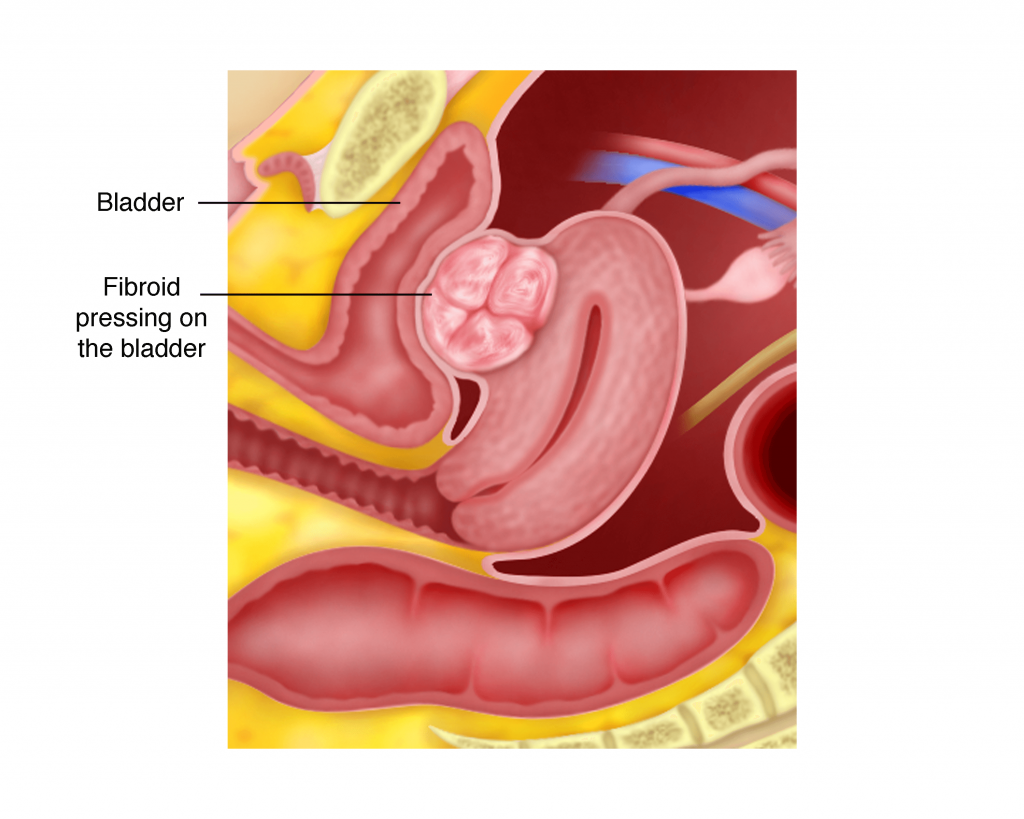
Case 2.2 : Fibroids that cause sudden inability to urinate
MS, a 43 year old lady, married with no children, came to seevme in August 2014 with a problem of several episodes of inability to pass urine requiring catheterization. She also complained of needing to go to the toilet up to 12 times a day. Examination revealed a large 14 x 8 cm posterior cervical fibroid and another fundal fibroid measuring 8 x 6 cm. She could not decide whether to undergo a myomectomy or a hysterectomy. She finally decided to undergo a hysterectomy. A total laparoscopic hysterectomy (g) was performed in October 2014. Postoperatively, she still could not pass urine. She was sent home with a catheter. The catheter was later removed and even though she could pass urine after removal of the catheter, she could only pass in small amounts. She was taught self-catheterization. Every time after she passed urine, she had to catheterize by herself and to measure the amount of urine that came out (residual urine). Her residual urine became lesser with time.
Discussion
Fibroids can press on the bladder and can cause frequent urge to pass urine. It can sometimes cause retention of urine. Chronic retention of urine as a result of fibroids can cause difficulty in passing urine even after the fibroid is removed. Patients who develop sudden retention of urine because of a fibroid should remove the fibroid or the uterus as soon as possible.
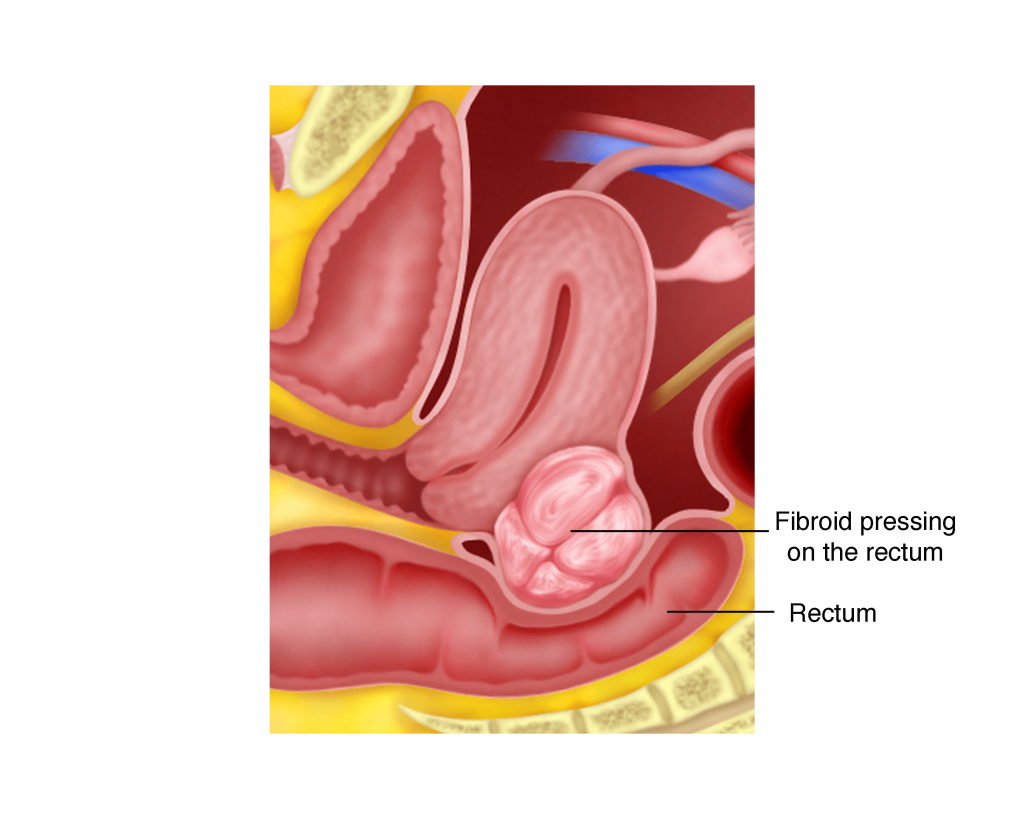
b) 便秘:子宫肌瘤对直肠的压迫也可导致便秘。
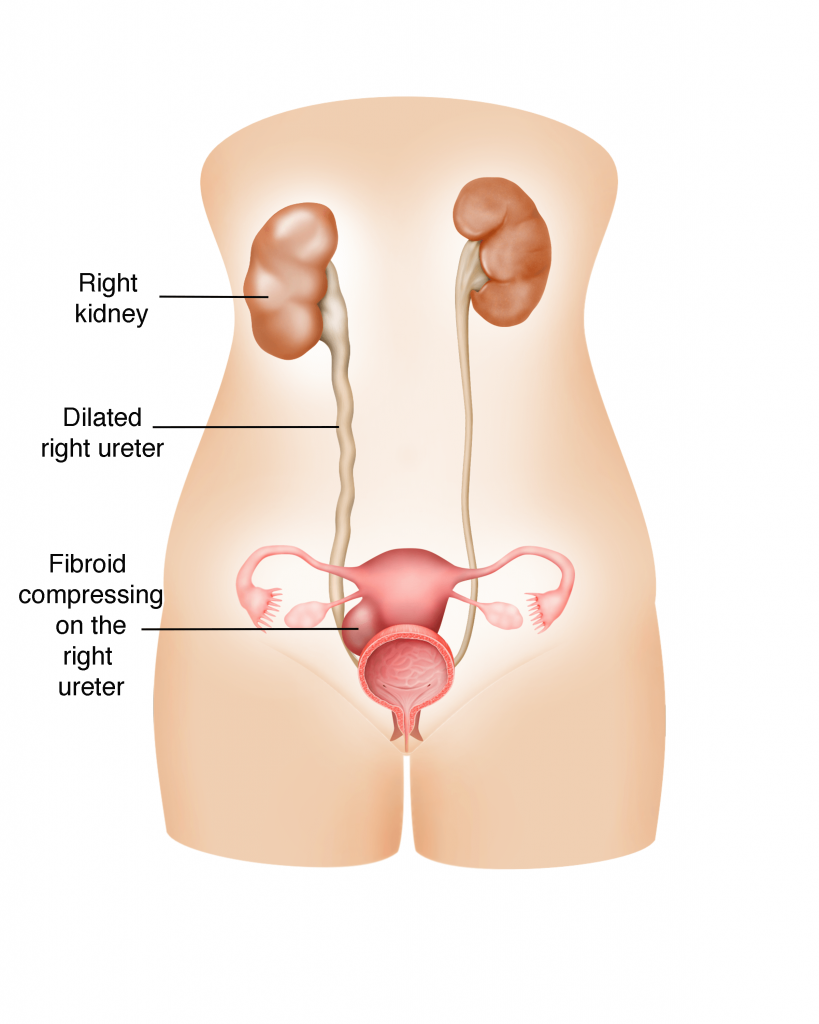
c) 肾积水导致肾肿胀
当子宫肌瘤偶发性的压迫在输尿管上,這会阻碍尿液由肾脏流向膀胱。累积在障碍后方的尿液最终会扩张至整个肾脏。 这就被称为肾积水。这現象可导致泌尿道感染或甚至对肾脏造成永久性损坏。
3) 腹腔疼痛
子宫肌瘤引起腹腔疼痛的原因有几个,包括:
a) 肌瘤突變
当子宫肌瘤生长到某个体积时,它的血液供应已不再充足。这会导致肌瘤中心区域血液供应量不足,子宫肌瘤便开始从内部退化突變。 换言之,子宫肌瘤內的肌肉组织因缺氧而改變。这过程将会引起剧烈腹痛,并可持续数天甚至一个星期或更久。
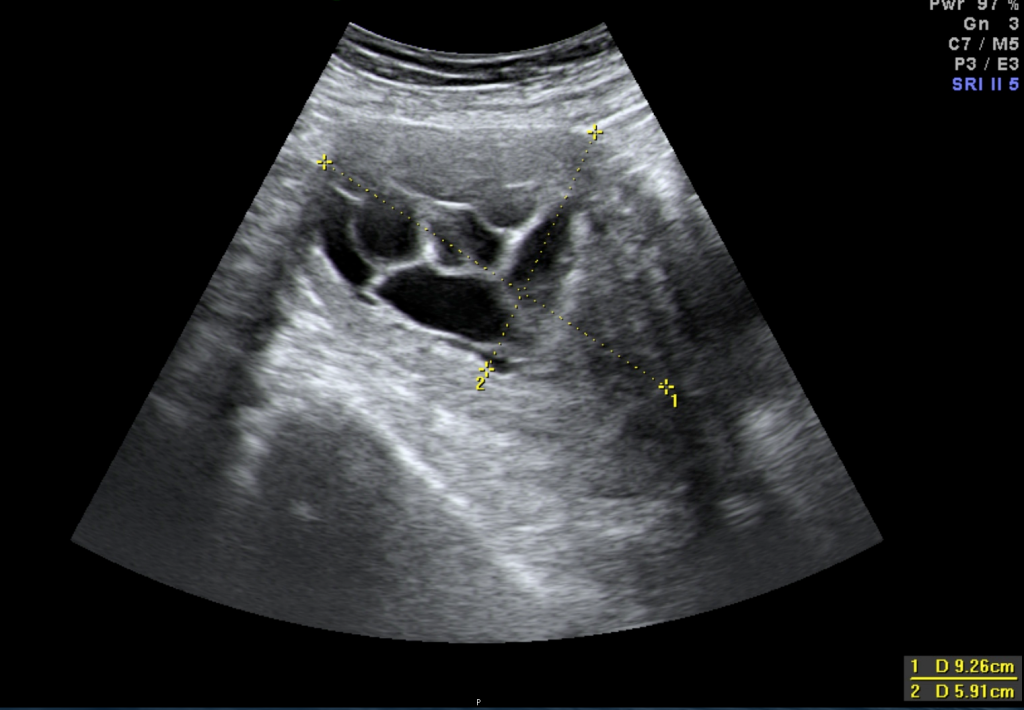
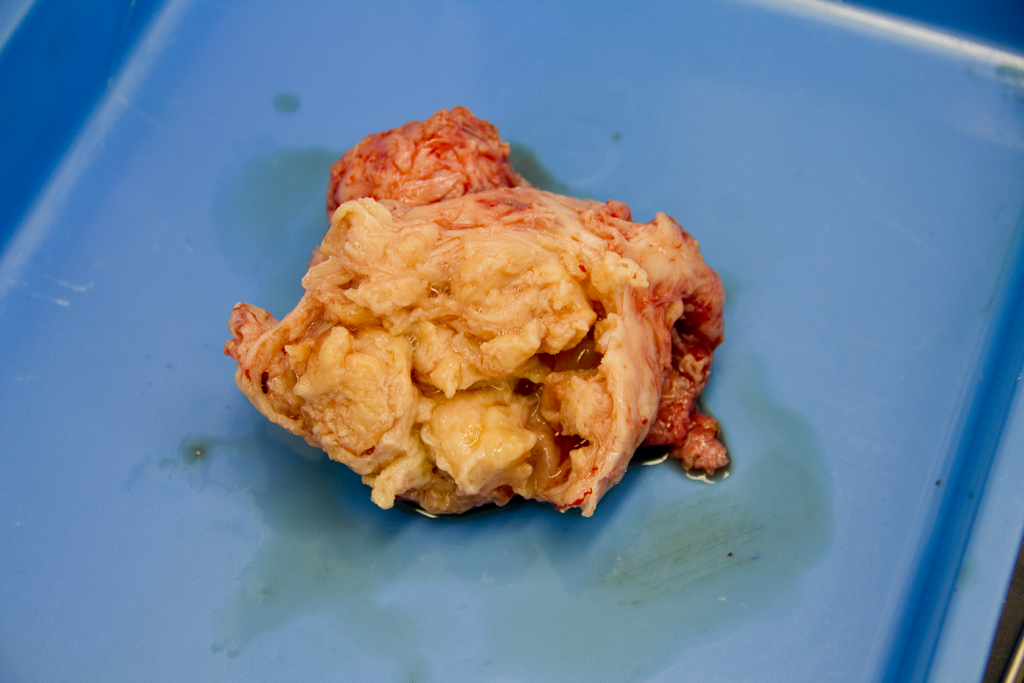
b) 蒂肌瘤扭曲
当带蒂肌瘤发生扭转,这現象可引起难以忍受的剧痛。患者就急需立刻施行手术切除肌瘤以舒缓疼痛。另一种可能发生的情况是; 扭转的带蒂肌瘤阻碍了子宫肌瘤所需的血液供应,反而导致子宫肌瘤开始退化。但这过程也一样会引起剧烈腹痛。
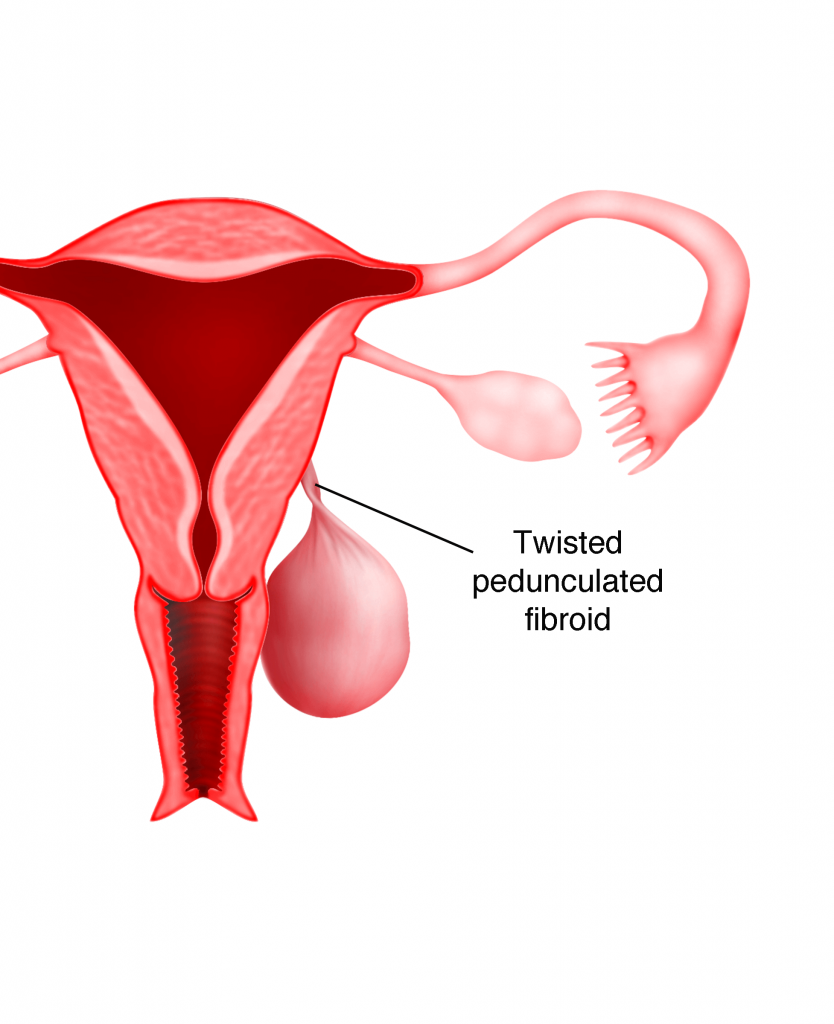
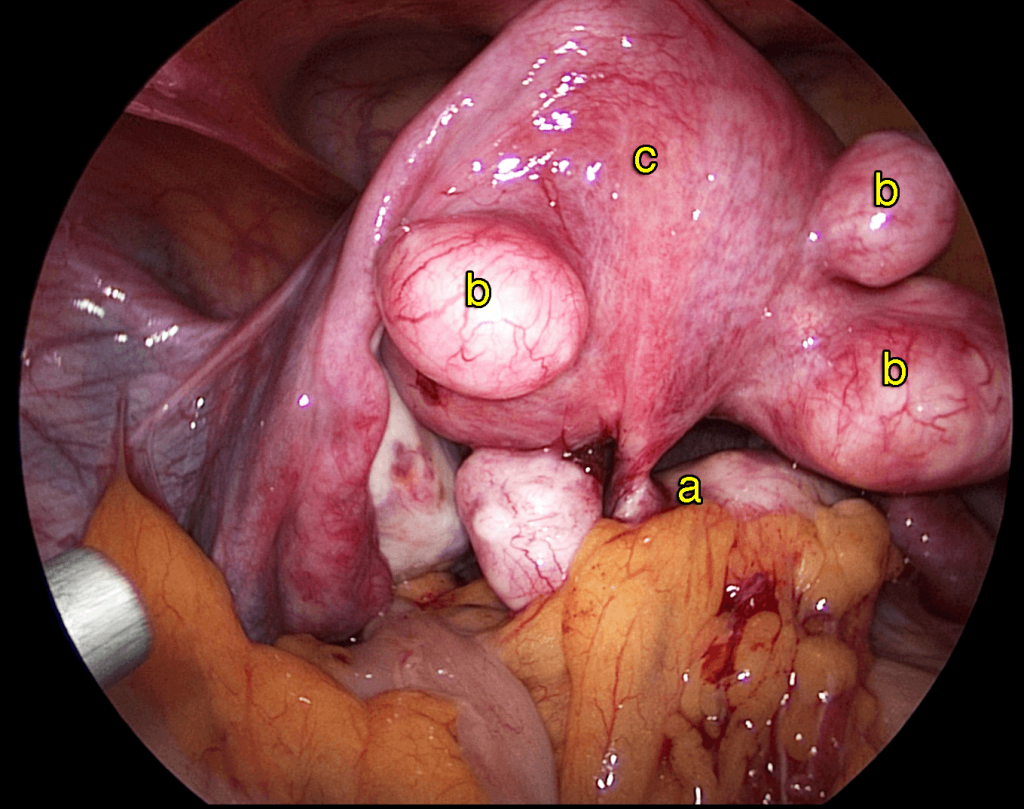
c) 子宫肌瘤感染
一个退化或死亡的肌瘤可以偶发性的感染周遭的子宫组织,因而引起疼痛。
d) 子宫肌瘤恶性宊变
极少數子宫肌瘤会演变为恶性或癌肿瘤或称为平滑肌肉瘤; 其发生率仅佔千分之一。但当这确实发生时,恶性组织将入侵子宫周围的正常组织,并引起激烈的盆腔和腹部疼痛同时可伴随阴道异常出血。
Can the diagnosis of a uterine sarcoma (cancer of the fibroid) be made without surgery?
Fibroids are very common and are mostly benign. They are usually suspected during an abdominal and a pelvic examination and confirmed on an ultrasound examination. There is no conclusive test that can be done to confirm if a fibroid is a cancer (sarcoma). In postmenopausal women where fibroids are growing, a cancer can be suspected but it still cannot be confirmed until surgery is done to remove the fibroid or the uterus. There are ongoing studies to diagnose a uterine sarcoma before surgery. One such study looked at performing MRI using a dye called Gadolinium and a LDH blood test to predict whether a fibroid is a sarcoma. However, this test is still not commonly available.
4) 不孕症
长在输卵管的子宫肌瘤可压迫输卵管并阻障卵子和精子的通道,降低受孕率。此外,长在子宫肌壁内的子宫肌瘤可严重扭曲或佔具子宫腔,尤其是子宫内膜,干扰血液供应,大大地使着床率减低。
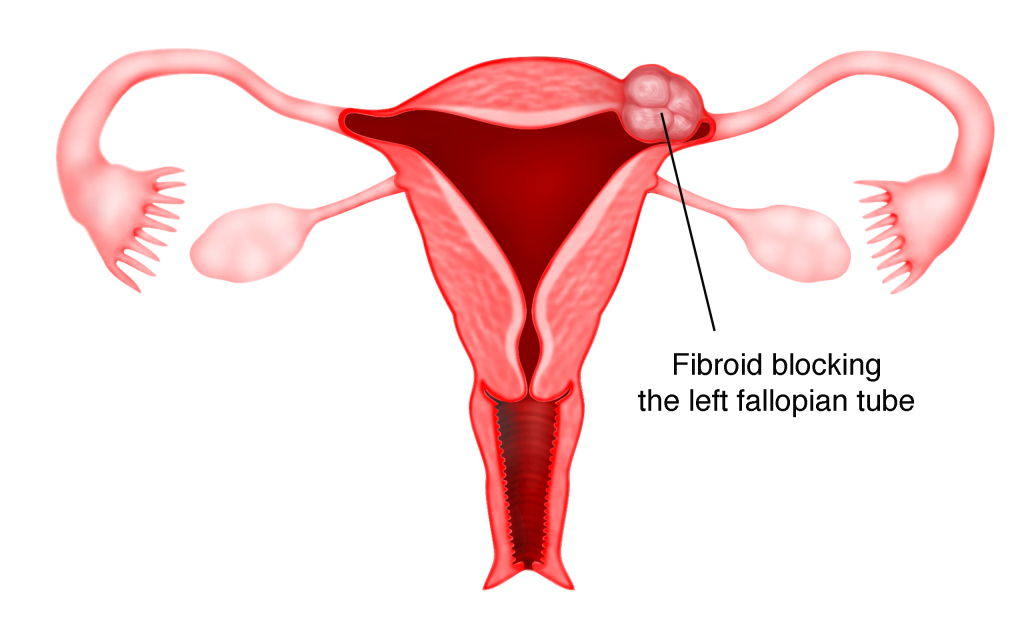
子宫肌瘤的诊断可通过以下方式进行:
1) 患者的医疗和家族病史
详细地掌握患者的医疗和家族病史有助於解开子宫肌瘤的疑虑。肌瘤的形成和遗传病史息息相關,因此病患的家族病史有助妇科医生判定肌瘤的存在机率。
2) 骨盆腔检查
毫无肌瘤症状的患者通常是在例行骨盆腔检查时才发现患有子宫肌瘤。妇产科医生通常会在他们的下腹部发现圆型肿块; 然而子宫肌瘤的存在无法像其他疾病如子宫腺肌病或卵巢囊肿能单独通过骨盆腔检查获得证实。尤其是当肿块被发现座落在下腹部的两侧,可以被误诊为子宫肌瘤或相反病症。因此需要配合其他的评估技术,如查看患者的家族病历,再結合超音波扫描和磁共振成影像(MRI)來加以证实和诊断。
3) 超音波检查
大部分子宫肌瘤能通过超声波检测到。这超音波扫描可通过腹部或阴道进行。由于阴道超声仪器較接近子宫,因此阴道超声波检查可更清晰的提供各子宫肌瘤的大小和位置。有了超音波扫描结果再结合骨盆腔检查, 通常就足以诊断子宫肌瘤。
4) 核磁共振影像
在一些情況下, 核磁共振成像检查可作为一项最有利的判诊。它是到目前为止是最准确的子宫肌瘤诊断工具。它能提供比超音波检查更详细的子宫肌瘤影像並协助妇科医生加以确定子宫肌瘤的实际数量,大小和位置; 甚至於肌瘤对周围器官的侵犯和損坏程度(anatomical distortion)。
5) 子宫腔镜检
子宫腔镜检是一种允许妇科医生通过子宫颈插入一个细管状望远镜或附加相机的子宫腔镜以直接检查患者的子宫腔內的技术。它能有效地诊断出子宫黏膜下肌瘤及子宫内膜。这种技术最適合用來检查有不正常阴道出血和/或习惯性流产的病人。(见第3节)
可选择的治疗方式
施行手术是最标凖的治疗方式。子宫切除术及子宫肌瘤剔除术是最常见的手术。子宫颈切除术可用于切除黏膜下肌瘤或用以替代子宫动脉栓塞术(UAE)。
1) 子宫切除术
子宫切除术是去除整个子宫包括子宫颈的手术。这可以通过腹腔镜或剖腹手术来进行。它適合用于已完成家庭和年龄高于40岁以上的患者。子宫切除术比子宫肌瘤剔除术更占优势因为它能消除子宫肌瘤复发的可能性,并杜绝了所有的症状包括经血过量。相較之下, 这些症状仍然可能存在於子宫肌瘤剔除术完成后。
2) 子宫肌瘤剔除术
子宫肌瘤剔除术是在不除去子宫情況下, 只取出肌瘤的手术。它可以通过腹腔镜或剖腹手术来进行。子宫肌瘤剔除术主要的优点是,它可以保留患者的子宫,允许患者在未来有机会受孕。但缺点是,它可能在手术过程中造成大量失血以致於需要输血。其他缺点还包括子宫肌瘤有可能在手术后复发和手术后持久性经血过量。在术后复发案例里,再一次施行子宫肌瘤剔除术会变得更复杂。这是因为前一次手术有可能导致切除部位组织形成粘连(疤痕组织)。
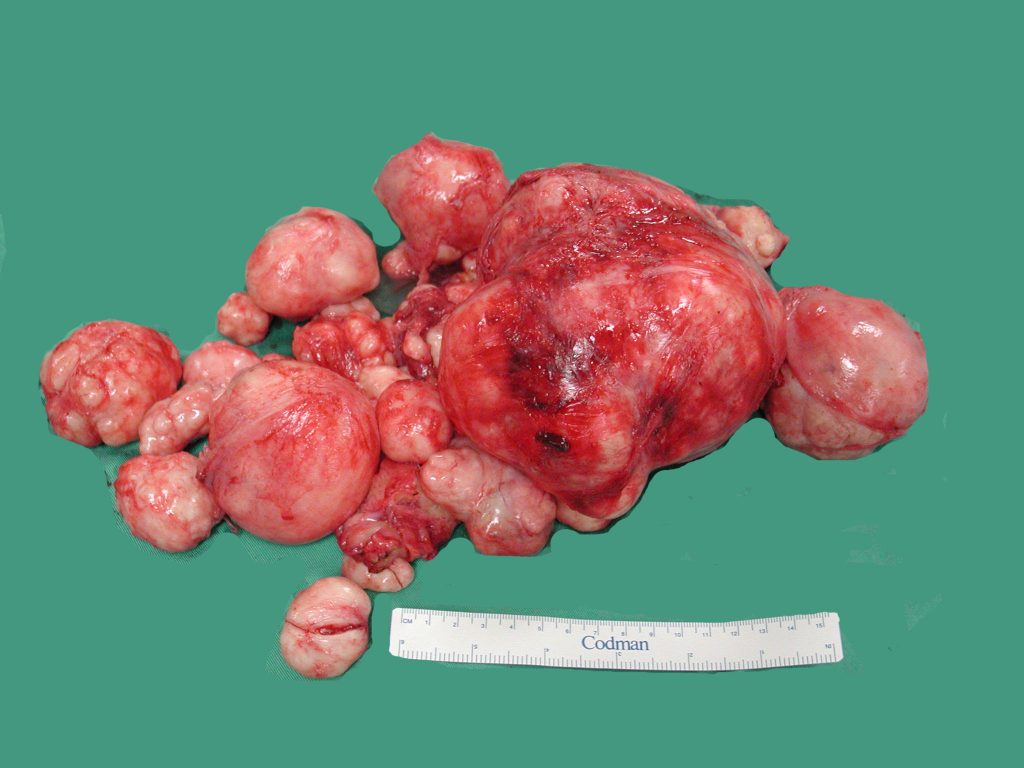
3) 子宫颈切除术
这手术适用於切除体积较小的子宫黏膜肌瘤。电切镜可用来把子宫肌瘤切成小块直到子宫肌瘤的最基低的部位然后再将这些小碎片通过阴道移除。

Watch Video 2.1
Uterine fibroid –
https://vimeo.com/149599112
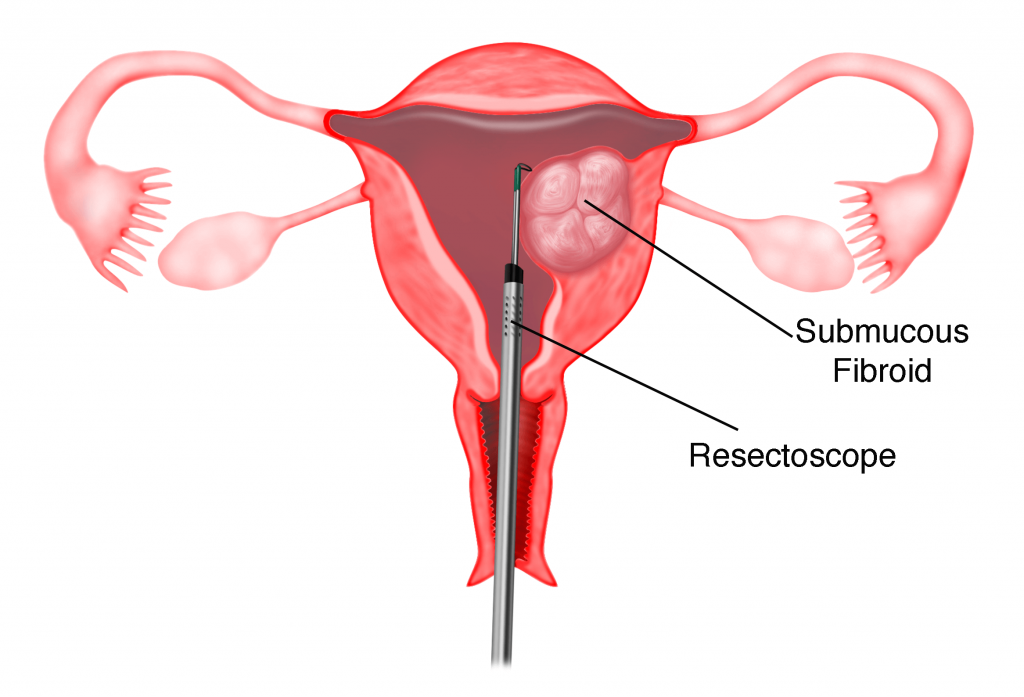
4) 子宫动脉栓塞术(UAE)
UAE是由有经验的放射科医生通过放射线影像(X光透视)来进行。 过程包括使用一个小导管通过腹股沟区的切口穿入股动脉和子宫动脉 再通过导管注入一些微小的砂粒状颗粒子进入子宫动脉以阻止子宫肌瘤的血液供应。
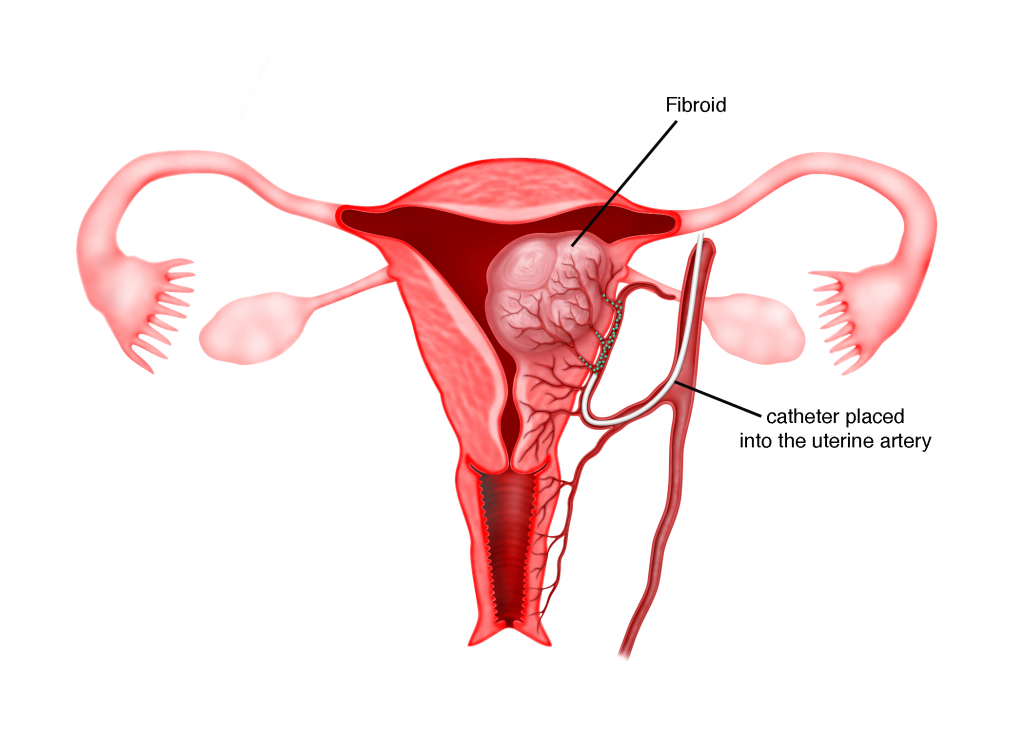
阻塞或栓塞最终会导致子宫肌瘤退化。UAE的优点是流血量少,生育能力不受影响及恢复期短。缺点是患者可能会在手术后遭遇栓塞综合征(PES)如严重的骨盆腔疼痛,抽筋,恶心和呕吐。栓塞也可能会损坏子宫和造成子宫内发生感染。当子宫肌瘤开始退化,这可引起严重的腹痛。
由于子宫肌瘤通常会在停经后自行解体或萎缩,所以通常不建议患有子宫肌瘤小于5厘米且无症状的患者动手术。这些小且无症状的肌瘤,不需要治疗但需不时的监视它们的成长。
结论
总结论,子宫肌瘤是女性最常见的良性肿瘤,它们通常是无症状且不需要治疗。但一旦症状出现时,治疗便是必要的。
